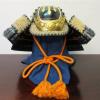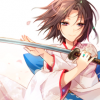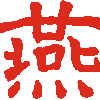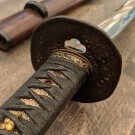-
Posts
3,046 -
Joined
-
Last visited
-
Days Won
73
paulb last won the day on August 8 2024
paulb had the most liked content!
About paulb

- Birthday 01/25/1955
Profile Information
-
Gender
Male
-
Location:
UK
-
Interests
Koto swords, especially pre nambokucho.
Profile Fields
-
Name
paul bowman
Recent Profile Visitors
10,277 profile views
paulb's Achievements
-
Mister Gunto started following paulb
-
-
To pick up on Brian's point and clarify the original intent. What I was attempting to establish, initially for myself but then for a broader group was what was the feature that made me want to look more. Or what was it that first attracted me to a piece and made me think it was worth closer investigation. This was not/ is not an academic exercise nor is it a kantei it is simply an attempt to make us (me) stop and think and try and identify why something does or does not appeal. From my own point of view I found things to like in all of the examples shown, which is why all but one of them have at one time or another been part of my collection. I love4d the fine lines of both the Enju blade and the Tadayoshi and thought the Shikkake was magnificent. The Kunimichi is incredibly powerful when seen in hand and a great example of the smith's craft. So no right or wrong and not an academic study just what attracts you on a first date.
-
He was a very talented man. Condolences to his family and friends
-
Well Lewis it is a very big name. I think the shape is ok the proportion good and nothing offends. Like you I would have loved to see this when ubu.
-
Personally I find wakizashi more challenging in a lot of ways. I think today they suffer somewhat unfairly as "the poor relation". It's true they are far more common than other forms of sword. I think the fact they were not exclusive weapons of the Samurai also weighs against them in some peoples view. It is true that very many wakizashi we see are what might be considered utilitarian and to coin a much used Japanese phrase "of little artistic merit". However a couple of things to consider. A samurai entering a house left his katana at the entrance. The Wakizashi was carried by him at all times. It was there for personal protection and also to enable him to protect his lord. But it also said something about him it enhanced an image he might be trying to project to those around him. As a result we see far greater variation in shape and design of blades than that seen in long swords. We then add to that mix older blades, long swords and pole arms that have been modified to be carried as a wakizashi. We need to consider whether this was because the blade was a much loved heirloom or the owner was attempting to save money by recycling. I hope that the four examples here show some of these aspects. starting at the top: - A large Katakiriba-zukuri wakizashi with a steep ioiri mune by Dewa (no) daijo Fujiwara Kunimichi. This is a substantial piece made to impress. Made in the middle of the 17th century it is an in your face statement. The blade is large and heavy the horimono elaborate. - An O-suriage blade attributed to ko-Enju and dating from the mid to late Kamakura. As Kirill mentioned it has an O-maru boshi which is a strong kantei point which distinguishes Enju from Rai work. If the boshi on this was ko-maru I think it would have papered to Rai Kunimitsu. Its is a beautiful blade. I would have loved to have seen it in it's original form. - The tihrid is a naginata-Naoshi It has a juyo attribution to the earlty Shikkake School and dated to the early Nambokucho. Again it is a beautifully crafted piece which has been shortenned with great skill. This would not have been an inexpensive thing to do which suggests it has been valued by previous custodians. - The Final blade is by SHodai Tadayoshi. It is suriage but retains the njimei signature. Based on the style of the mei I believe it was made between 1612 and 1617. I am also guessing that it was shortenned to conform to the edict dictating the maximum lengths of sword which I think came in to force in 1638. In its' original form it would have been too long to comply.
-
Following the earlier post on shape and Brian's suggestion I have posted some wakizashi images below. The variation and range of shapes in wakizashi is far greater than that seen in longer blades. I hope I have captured a range below. One glaring omission is a hira-zkuri example but unfortunately I did not have one amongst my stock images. As in the previous post see which shape appeals to you most.
-
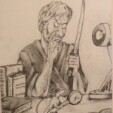
How old where you at your first nihonto acquisition ?
paulb replied to Benjamin's topic in General Nihonto Related Discussion
Crickey I just realised I was 27 when I bought my first sword, which I kept for about 14 years. Means I've been collecting for over 42 years now! -
Lewis, I use this as an example of "shape doesn't tell you how old a sword is but it can tell you how young". This is trying very hard to be a Heian/ early Kamakura period work but it was actually made about 200 years later in the Oei period. There was no attempt to deceive by the smith he signed it with his own name, Yasumitsu. The shodai was working in the Oei period at a time when the incumbent Shogun was attempting to move away from what he perceived as the excesses of the Nambokucho period and attempted to return to the more subtle forms of the early Kamakura. I do think the shape really does illustrate what first attracted me to Japanese swords there is a severe elegance that I am challenged to describe in a meaningful way but that really grabs my attention.
-
Just as a final piece I think I'd feel a little guilty talking about shape if I didn't include the example below. It is Ubu, exhibits fumbari and has one of the smallest ko-kissaki I have seen on a tachi. I think it is stunningly beautiful
-
I think it is probably time to offer an explanation of what was behind the original post and I am grateful to Brian for suggesting people select their first pick up. It helped illustrate the point I was hoping to make. The majority of participants selected no.4 as their first preference with no.3 coming in close behind. No.4 has been taken to a number of exhibitions and study days for people to examine. Sitting alongside other pieces it has been largely ignored. It is very conservative, the hada is not immediately visible and the complexity of the hamon needs close study. As a result people tended to leave it on the table and gravitate to the larger and more flamboyant pieces that were also on show. However when restricted to focusing on shape something people saw in no.4 drew them to it. The somewhat laboured point I am trying to make is that we should, as Walter Compton said in his 100 masterpiece volume, look at shape before we look at anything else. I still maintain that regardless of whether it is ubu or suriage a good sword will never have a bad shape. Once we have studied the shape move on to the other features that can tell us a great deal more. For those who want to know what they were looking at: 1. A mumei shin-shinto piece attributed to Aizo Tadamasa by the NTHK 2. O-suriage katana with old NBTHK papers to Daido. I think this falls in to what Darcy so eloquently described as a typical "bucket attribution" . it could be the work of a number of smiths and Daido was a safe choice. 3. Has a shumei and sayagaki attributing it to Aoe Tsunetsugu. The NBTHK Juyo papers from the 13th session attributed to Aoe and dated it to the late Kamakura period. Interestingly they do not describe it as having O-kissaki leaving it at extended chu-kissaki. They also mention the shumei but state that this does not refer to the Ko-Aoe master of that name. 4. This blade has three separate attributions to the same smith Awataguchi Norikuni who was working in 1220 and one of Go-Toba resident smiths. It has Hozon papers and as far as I am aware it has never been submitted for higher papers. It does however have a sayagaki by Tanobe Sensei in which he describes it as "A masterpiece of the Kamakura period". Awataguchi work is not common Norikuni's pieces are rare and highly regarded I think at the last count there were seven of his blades awarded Juyo certification and four of those were tanto. There is one national treasure piece which is suriage but retains the mei. This piece has a great many similarities to that work. This is amongst the finest examples of sword making I have had the opportunity to study in the past 40 years. However it requires time to look and appreciate it. looking at the shape first and in detail gives the observer that little extra time to start to see the detail.
- 28 replies
-
- 12
-

-

-
I am not sure how to respond Kirill. I mentioned in the original post that shape was the feature that originally attracted or deterred me. Whether ubu or suriage the shape has to have some aesthetic quality that appeals to me and what appeals to me may not appeal to you (as it obviously doesn't). I di not suggest that these were examples of A+ sugata although thankfully in at least two cases the NBTHK think they are. The piece you suggest might be bought fishing at sword shows has been described as " A masterwork of the Kamakura period" Theblade you decxribe as a traumatized Chogi received Juyo papers and has a sayagaki by Honami Kozon both describing the blade as "despite being suriage having a typical shape of the period" It is of course incredibly difficult to make a judgement based on a single image (B&W or otherwise) and this is made more difficult without any suggestions of size. This wasn't the purpose of the post.
-
In various presentations and articles I have often quoted many expert voices telling us the importance of shape and how it can tell us a great deal about a blade. I believe this to be true but for some reason have only just realised how much it influences my ideas regarding the desirability of a sword. On reflection I believe that in every case it has been the shape of a blade that has first grabbed my attention. If the shape looks good carry on looking if not walk away. I hasten to add this is not based on any criteria other than aesthetic appeal. I have posted an image below of a number of different blades, all are suriage so attempting to date them based on shape becomes immediately more challenging. They are very different but all caused me to stop and look in more detail.
-
congratulations. It looks extremely good
-
Colin, I started what would have been a lengthy reply offering an opinion on what constitutes an art sword but realised I was repeating myself. In 2020 I wrote an article which was posted here and on the Token of GB website. As usual I couldn't find my way to the articles section here (my problem not the sites) so have listed a link to the version on the Token Society website. I am sorry if this appears idle and or self promotion but I think it explores the idea of a sword being art beyond those expressed here so far. why article.pdf (to-ken.uk) much of what I have said in this was quoted from far better scholars and more knowledgeable people than me. I don't believe those opinions were elitist or based on protecting investment (mine certainly aren't) but I hope the points offered make some sense.
-
Jacques We have had this conversation in the past my understanding has always been that being awarded a hozon paper means it is worthy of preservation. It therefore has to be in reasonable condition and without fatal flaws. Exceptions may be made if something has a valuable history. But a hozon papers says more about a blade than just the mei is authentic. Has something changed recently?





